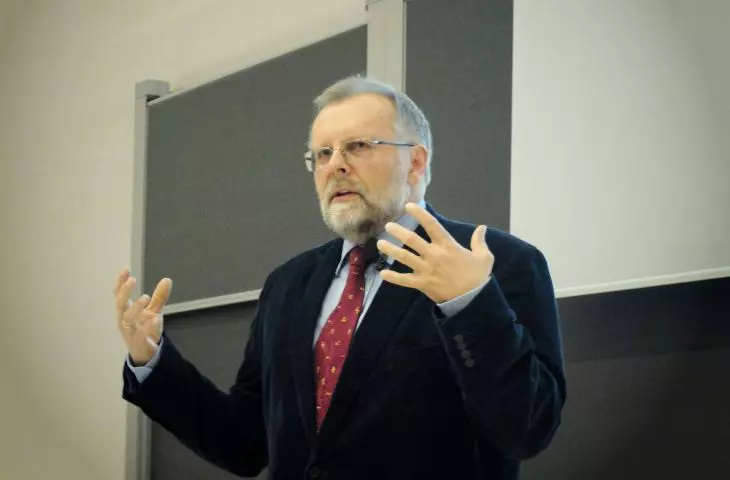The conversation is from A&B issue 10|23
Professor Szymon Malinowski, an atmospheric physicist, in conversation with Ania Diduch about the lack of understanding of the issue of water and biodiversity in urban planning and architecture.
Ania Diduch:In your opinion, does the unsustainable and irresponsible management of water resources stem from a lack of education? And if so, can you indicate what kind of deficiencies these are?
Prof. Szymon Malinowski:It is difficult to say whether this is just a direct result of poor school education. Water is the resource we all know theoretically, if only from a simple diagram in textbooks: that water evaporates, forms clouds, and then falls to earth in the form of rain. Of course, the devil is in the details, because this process is not so simple at all. We are accustomed to the fact that water was readily available, at least in many parts of the globe, but we forget that we are increasingly influencing its circulation. Civilization interacts with the water cycle, and understanding the new paths of its circulation is very difficult for many people.
Sustainable thinking about water in architectural practice begins with understanding the water cycle in nature
Photo: Public Domain Pictures © Pixabay
Ania:It seems to me that the drawing you mention, which I also remember from my school days, builds a false image that water is a renewable and non-transferable resource, that it is a closed cycle.
Prof. Szymon Malinowski:The fact that water is in a closed cycle and is renewable does not mean that this cycle is able to invariably and continuously occur everywhere. Locally, as residents of cities or settlements, we are not directly dependent on the global cycle. The point and manner in which we are locally plugged into the global cycle reveals a very important role.
Ania:If so, are architecture and urban planning the disciplines that should be responsible for how this local cycle is organized?
Prof. Szymon Malinowski:I think to a large extent yes, these two fields and urban planning. Besides, architecture and urban planning should be responsible for how buildings and cities function in nature. Construction to this day only focuses on functionality from the point of view of people. The question of how buildings or urban systems function in nature is completely ignored in the design and construction process.
If we take the mass of all man-made objects on Earth, in which architecture and urban planning have a sizable place, it turns out that this mass is greater than the mass of all nature
Photo: Pete Linforth © Pixabay
Ania:So the reasons are systemic: we are doomed to the fact that there are no global meta-rules to regulate a more holistic way of thinking.
Prof. Szymon Malinowski:It's not about metaprescriptions, it's about understanding context and scale. For example, if we take the mass of all man-made objects on Earth, in which architecture and urban planning have a sizable place, it turns out that this mass is greater than the mass of all nature. Our civilization long ago exceeded the scale of local activities, even if individual projects are perceived as such. Today, we are simply changing everything on Earth, and we often do it unconsciously. This unconsciousness flows from an incomplete perspective: the leading requirement of architecture and urban planning is that it should meet human utility and aesthetic conditions. In turn, there are virtually no requirements and needs to understand how construction correlates with the water cycle, biodiversity, how to design these relationships.
Ania:How then can you begin to implement this change in thinking?
Prof. Szymon Malinowski:The biggest problem is the lack of time to experiment. We don't have the luxury of waiting for a new mentality to develop.
Ania:I agree: time is another resource that is running out today.
Prof. Szymon Malinowski: The problem is pressing. We need a rapid paradigm shift not only in the field of architecture. This is not easy, because very few people understand what this is all about - we are lost both in understanding the problem and in ideas for a remedial plan.
Civilization interacts with the water cycle and understanding the new paths of its circulation is very difficult for many people.
Photo: Arek Socha © Pixabay
Ania:Who has the greatest responsibility of making sure we stop being confused?
Prof. Szymon Malinowski: In my opinion, the most should be demanded precisely from those who design and build: architects, urban planners and urban planning specialists. I think it would be most effective if they communicate with naturalists and earth science specialists who know the local hydrological, climatic, natural conditions and constraints, so that architects can take them into account in their work. This sounds like a temporary solution, but it can be effective. I don't see any hope of quickly and efficiently generating a new law that would simply address the intricate relationship between urban planning and nature.
Treatments involving the construction of green roofs are clearly inadequate, sometimes even implemented by force
photo: nathmath © Pixabay
Ania: The new design methods you mention are supposed to apply to what is being built, or to objects and cities that already exist?
Prof. Szymon Malinowski:Under construction and existing ones. By the way, I would like to point out that some of the design concepts may be imperfect due to ignorance of certain environmental factors. For example, the concept of a fifteen-minute city is very tempting from the perspective of people, but in order for it to fully fit into the operation of the environment, we should first have an effective method of counting the carbon and environmental footprint. The search for answers to the question of how to plan convenient cities so that the environmental impact is as small as possible can start from this. I want to emphasize the importance of design thinking in terms of balance. You have to combine two perspectives: that people can live well and comfortably, and that these comforts have the smallest possible environmental footprint. As a climate scientist, I have to say that, for example, efforts to build green roofs are clearly inadequate, sometimes implemented even by force. They don't necessarily contribute to the protection of ecosystems at all, and they don't come from thinking about architecture as an element of nature. The design of green spaces is unfortunately thought of in a similar way: from the perspective of amenities for humans, rather than creating conditions for nature to function freely. One example is the revitalization of Mokotow Fields: on the one hand, nature refuges have been designated, which is a great idea, on the other hand, the old concrete in artificial ponds is being replaced on a grand scale with new concrete.
The idea of a fifteen-minute city is not fully efficient when it comes to managing the climate crisis
Photo: Gundula Vogel © Pixabay
Ania:Do you think that one aspect that could accelerate the necessary changes in law and mentality is simply economics? Finding a way for the right people to finally realize that going against nature and against the environment simply doesn't pay off for anyone.
Prof. Szymon Malinowski:It seems to me that even at the level of planners we are powerless. To illustrate my point, let's consider that fossil fuel subsidies account for 7 percent of gross global product. From this simple statistic, you can see that our entire economy is skewed toward the exploitation of non-renewable resources. We don't take into account the cost of environmental services or the loss of those services due to poor planning. Anyone can pave their land with Baum's pavers, there are requirements that a certain percentage of the surface remain permeable, but that's about it. Likewise with putting up a fence, which negatively affects both the water cycle and biodiversity. No one can imagine their private land being subjected to environmental requirements.
The global water circulation is one phenomenon, but at the scale of cities, we are plugged into the local circulation; this is why water management in urban planning is always strictly contextualized
Photo: Joel © Pixabay
Ania:Yes, it is an almost inalienable right. How does Poland compare with countries that are pursuing a sustainable approach to the environment?
Prof. Szymon Malinowski:Our spatial management is historically linked to the system of settlement under Polish law, to the history of property. Poland is very fragmented and divided. Basically, anyone can put a building anywhere: forest or no forest, fence, driveway, they have to be. If there are restrictions, they are usually circumvented, which is due to a strong attachment to property: what do you mean, I can't do what I want on my own land? Except that it's not just our land. The cycles I mentioned above occur on it: water, carbon cycles, ecosystems also "work" on all of us. Nature is treated from this perspective as an inconvenient element to be tamed. A tree is seen as something that can fall over and mess us up. This is compounded by design mistakes resulting from a lack of understanding of how nature works.
Urban design should be done in consultation with climate and nature specialists so as to provide the necessary biodiversity
Photo: Rahul Pandit © Pixabay
Ania:Are there any positive examples of a sustainable approach to the urban water cycle?
Prof. Szymon Malinowski:I would mention green retention solutions in Radom. Another area that is changing is the approach to forests and green areas inside and around cities, which are not only meant to be places of recreation, but to provide a certain level of biodiversity. How to support these positive changes? By constantly reminding us that when designing a city, a neighborhood, a transportation system, we should minimize the environmental footprint, not only by introducing new solutions, but above all by preserving as much as possible all the natural and semi-natural ecosystems around us.
The most should be demanded precisely from those who design and build: architects, urban planners and urban planning specialists
Photo: Snehanshu M © Pixabay
Ania:Over the years of your work, how has the way you talk about nature and its relationship with humans changed? You yourself are an important protagonist of this change as a popularizer of climate knowledge.
Prof. Szymon Malinowski:Changes in the narrative for the better do exist, but they are niche. And they don't extend to the general public, which is something I experience every day as a popularizer of knowledge in this area. Instead of systemic thinking, we still have faith in fashionable miraculous solutions, once it's "flower meadows," once it's "planting trees." The worst thing is the progressive detachment of man from nature, the progressive lack of understanding that in many cases nature should be left alone, vigilantly observing and sometimes helping it a little, or a little limiting our own needs.
Ania:Thank you for the interview.
interviewed {tag:AutorAiB}
Szymon Malinowski - Professor, atmospheric physicist and director of the Institute of Geophysics at the University of Warsaw. He serves as chairman of the Climate Crisis Team to the President of the Polish Academy of Sciences. His commitment to popularizing knowledge is shown in the film "You can panic" (2020).







































